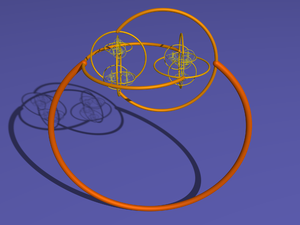Cantor tree surface
Appearance


In dynamical systems, the Cantor tree is an infinite-genus surface homeomorphic to a sphere with a Cantor set removed. The blooming Cantor tree is a Cantor tree with an infinite number of handles added in such a way that every end is a limit of handles.[1][2]
See also
[edit]References
[edit]- ^ Ghys, Étienne (1995), "Topologie des feuilles génériques", Annals of Mathematics, Second Series (in French), 141 (2): 387–422, doi:10.2307/2118526, ISSN 0003-486X, JSTOR 2118526, MR 1324140
- ^ Walczak, Paweł (2004), Dynamics of foliations, groups and pseudogroups, Instytut Matematyczny Polskiej Akademii Nauk. Monografie Matematyczne (New Series) [Mathematics Institute of the Polish Academy of Sciences. Mathematical Monographs (New Series)], vol. 64, Birkhäuser Verlag, p. 210, ISBN 978-3-7643-7091-6, MR 2056374
